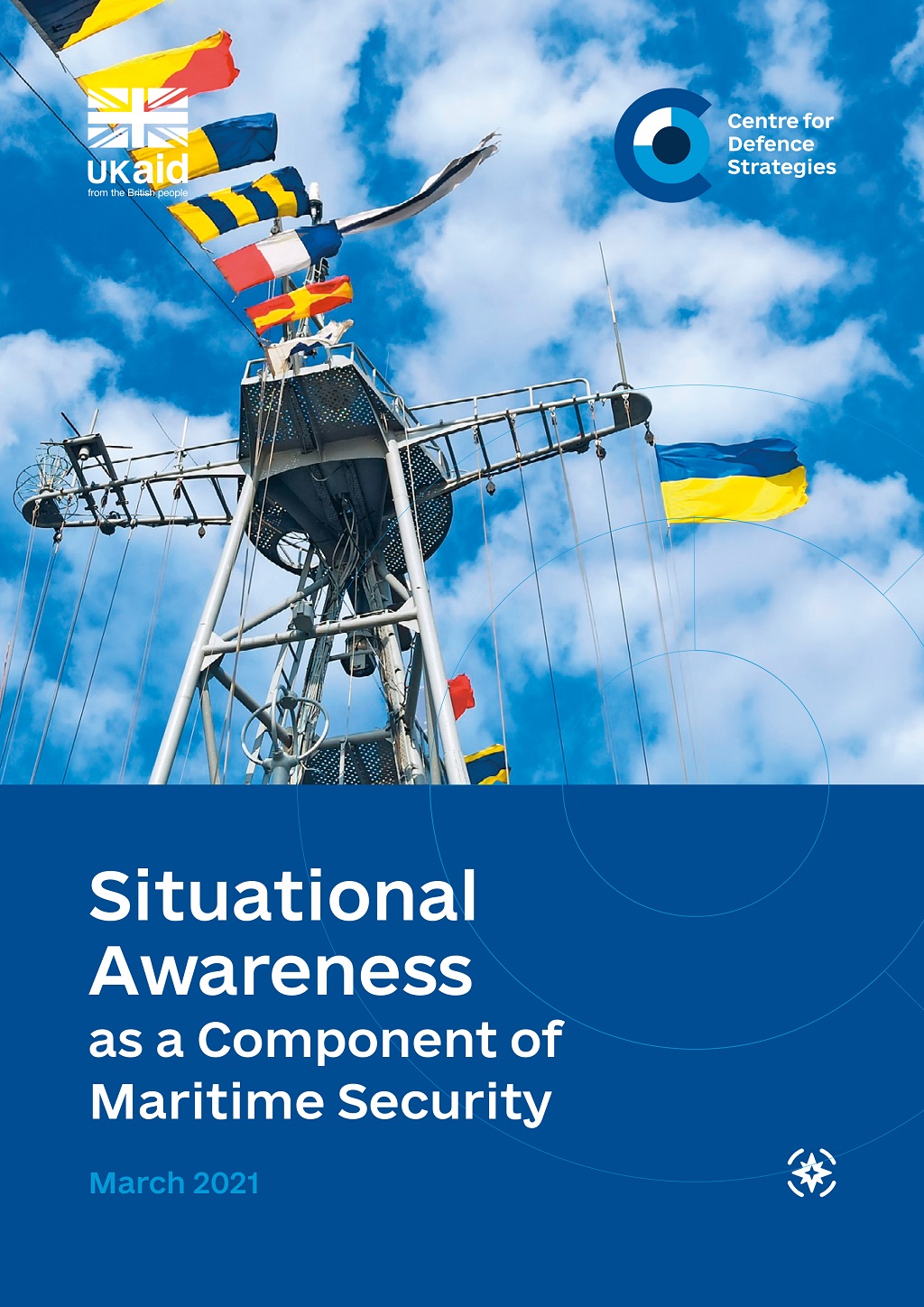Kateryna Bandura for New Pathway – Ukrainian News.
Fifth of Five Articles
Highlights from the “Situational Awareness as a Component of Maritime Security”, prepared by Oleksandr Khara, Centre of Defence Strategies fellow.
With its illegal annexation of Crimea and the following large-scale militarization of the peninsula, Russia has significantly magnified its military and other threats to Ukraine, to the countries of the Black Sea region, and to the European continent. Russia is capable of inflicting catastrophic damage to Ukraine even without the overt use of force from the sea. Thus, resolving maritime security issues is a paramount task not only for the Ukrainian Navy but for Ukraine as a whole.
There is an urgent need for defence capacities development. This includes the restoration of the Ukrainian Navy, the capabilities reinforcement of other defence forces components, their integration into a single force, their achieving interoperability with NATO, and the further integration of Ukraine into the Alliance.
There should also be a focus on a national strategy. Those who implement such strategy should be provided with necessary resources and processes of interagency cooperation, such as between the Ukrainian government, local authorities, civil society, and the business community.
Only a combination of these two components can rectify the situation.
Managing maritime security: Ukraine’s problems
The military aggression of the Russian Federation and the illegal annexation of Crimea have drastically deteriorated Ukraine’s security environment and deprived the state of several capabilities that are necessary to protect its national interests at sea. The events of 2018 revealed the ill-preparedness of the national security management system to countering non-traditional threats. It also highlighted problems with situational awareness and a lack of the necessary capabilities. For instance, it took almost two months for the government to acknowledge that Russia began the systematic obstruction of freedom of navigation in the Sea of Azov, aiming at economically suppressing the Ukrainian Azov region.
There is also neither a separate state institution responsible for maritime security issues nor a clearly defined mechanism for interaction between the existing bodies. Systematic monitoring of sanctions violations is still carried out only by a non-governmental organization – the Institute of Black Sea Strategic Studies.
Managing maritime security: solutions from other countries
To cope with emerging threats, the U.K. adopted the National Strategy for Maritime Security in 2014. The strategy identifies terrorism, the disruption of freedom of navigation, a maritime attack against U.K. infrastructure, arms proliferation, drugs and human trafficking as among the main maritime security risks. The Strategy consists of five conceptual elements: understanding, influence, prevention, protection, and response. The most applicable aspect of the U.K. Strategy to Ukraine is its first element – understanding. It covers intelligence gathering, information exchange, partnerships, data analysis, and risk identification. Marine risks are assessed on a semi-annual basis.
India is implementing its own maritime security strategy within the framework of the National Maritime Domain Awareness Project. They established the National Command, Control, Communication and Intelligence System, which includes the Information Management and Analysis Centre. The Centre brought together the lower echelons of the Navy and the Coast Guard spread across the country’s coastline. Other governmental agencies also have access to analytics and data from the country’s 51 radars; new radars are planned to be deployed in the Maldives, in Myanmar, and in Bangladesh. By modifying systems built by Raytheon Technologies, India’s Bharat Electronics has created a coastal surveillance and decision support system.
The most radical changes in the maritime security governance system have been introduced in the United States. In 2002 the U.S. Congress passed the Marine Transportation Security Act, which provided for the establishment of the National Maritime Security Advisory Committee at the Department of Transportation and the introduction of a relevant information and analytical system. The activities of the maritime security authorities are coordinated through the National Security Council (for strategic issues), the Maritime Security Interagency Policy Committee (for operational activities), and through established stakeholder interaction mechanisms.
An important element of ensuring the security of the above-mentioned countries is international cooperation and the implementation of various programs and initiatives. These include, in particular, the so-called concepts of the “Thousand-Ship Navy”, of “Strengthening Maritime Security”, and of the “Information Fusion Centre – Indian Ocean Region”.
Establishing a maritime domain awareness system
Maritime Domain Awareness (MDA) is the “effective understanding of anything associated with the maritime domain that could impact the security, safety, economy, or environment of a nation”. This awareness is a relevant topic for Ukraine because, in addition to soft threats from non-state actors, it is vulnerable to Russia’s military and hybrid threats. The establishment of a maritime domain awareness and situational awareness system is an important step towards ensuring Ukraine’s maritime security and building up capabilities to enable the de-occupation and reintegration of the temporarily occupied Autonomous Republic of Crimea and the city of Sevastopol.
The creation of such a system should be based on the following principles:
- Defining maritime security as a national priority;
- The asymmetric nature of the response to threats from Russia;
- Awareness that maritime security is to be dealt with by the whole of government, civil society, and business;
- Avoiding the creation of redundant structures; and reorganizing existing ones instead;
- Changes in management culture;
- International cooperation and integration into existing Euro-Atlantic and European systems.
Based on the MDA experience of the United States, the United Kingdom, and India, it is reasonable to divide the process of setting up a Ukrainian system into three phases:
- Taking immediate measures towards ensuring situational awareness. For example, the establishment of the Joint Situational Awareness Centre in Odesa will significantly improve Ukraine’s ability to identify seaborn threats to national security, coordinate the activities of relevant defence forces, and promptly advise the government and security structures of possible actions that could be taken.
- Developing system architecture and dealing with related problems. The Maritime Security Committee at the National Security and Defence Council should be the optimal tool for designing and deploying the MDA system. The Committee must become a coordinating body in the activities of public authorities regarding the restoration of the Ukrainian Navy in accordance with the Strategy of the Naval Forces of the Armed Forces of Ukraine 2035.
- Implementing such an architecture. The Maritime Security Committee should be transformed into the National Maritime Security Centre or the National Maritime Awareness Centre. The Centre must become a hub bringing together situational awareness centres and other structures that are responsible for various aspects of maritime security issues.
Conclusions
Ukraine still remains extremely vulnerable to maritime threats. The intensive militarization of the illegally annexed Crimea has allowed Russia to secure an absolute advantage at sea. The protection of Ukraine’s national interests requires an accelerated build-up of the Ukrainian Navy capabilities and other components of the defence forces. Given the hybrid nature of Russian aggression, it is necessary that the Ukrainian security governance system be adapted to the new realities. This requires a radical change in management culture and an approach where maritime security is dealt with by the whole of government, civil society, and business.
Ukraine must identify maritime security as a national priority and adopt the best maritime security practices, taking into account national specifics and the aggressor’s incommensurably greater combat potential. This requires the application of an asymmetric strategy: from building up the capabilities of the Ukrainian Navy based on the mosquito fleet concept to streamlining the management processes in the security and defence sector. It also requires integration into the Euro-Atlantic and European political and security structures.
Ensuring maritime security is an inalienable part of the strategy for the de-occupation and reintegration of the temporarily occupied Crimea.
This article is written under the Local Journalism Initiative agreement
Share on Social Media


































